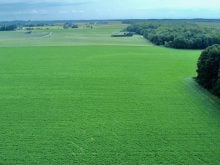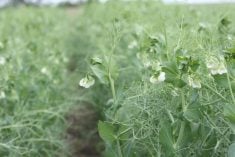Conference told that critical gaps in technology, policy and investment slow progress toward sustainable food systems
A decade ago, Josh Betcher’s fifth-generation Minnesota family farm came to a crossroads when it became clear that his father was no longer able to help with field work.
“We had to make a choice, to either hire someone, get bigger equipment or make a process change,” he told the room of corporate executives, academics and farm leaders at a Minneapolis conference focused on food system sustainability hosted by Reuters.
Related stories in this issue:
- Sustainability has a problem
- Regenerative agriculture resumes bottom-up approach
- Producers lose their climate villain reputation
The Transform Food and Agriculture USA conference brought food industry leaders together for two days to explore how aligning along common goals can work to reshape the food system in the face of climate change.
Read Also

Huge Black Sea flax crop to provide stiff competition
Russia and Kazakhstan harvested huge flax crops and will be providing stiff competition in China and the EU.
Betcher had been dabbling with soil-building practices such as cover crops and no till since 2013, when a spring weather event made it impossible to seed part of the farm. He took that setback as an opportunity to experiment with alternative practices with minimal risk.
Transitioning to a different labour dynamic brought some of those possibilities into sharper focus.
“We chose to implement regenerative practices through no till, strip till and cover crops and utilize that process to eliminate some of that activity that my father had fulfilled in the past,” he said.
The gamble paid off, even as he struggled to find the needed guidance to make the new management style work on his farm. The 500-acre mixed crop and livestock operation had its best production year ever in 2022. Perhaps more importantly, production came within two per cent of that peak again in 2023, a year in which they received 50 per cent of their average rainfall.
“The resilience that I had developed in my production system was shown and delivered in that drought year,” he said.
This year, in contrast, started out dry and turned wet, “but I’m still seeing a pretty valuable crop out there.”
Betcher is keenly aware there’s a lot riding on his ability to make choices that are sustainable, both economically and environmentally.
“Being a century farm — 140 years our families ran that farm … it’s really important to me to be able to provide that opportunity to the next generation.”
Farmers like Betcher are top of mind for Sanah Baig, the U.S. Department of Agriculture’s deputy undersecretary for research, education and economics. She oversees a portfolio of programs designed to help farmers meet the world’s growing demand for nutrition, adapt to a changing environment and stay in business at the same time.
“We have about 25 years to figure out how to feed the estimated 10 billion population with affordable, nutrient-dense foods, while also reducing food loss and waste, while conserving our natural resources, while safeguarding against new pests and diseases and while protecting biodiversity,” she said in her opening address.
Meeting those challenges will require producing 70 per cent more food, using 30 per cent more water and 50 per cent more energy, she said.
It’s an even more daunting task considering the latest USDA agricultural census data, which shows the U.S. lost 20 million acres of farmland, an area equivalent to the state of Maine, between 2017 and 2022. The number of farmers continues to shrink, and the ones that remain are consolidating as small and mid-sized farms continue to exit the business.
Less than one per cent of farms in the U.S. now account for 42 per cent of the sales. Meanwhile, the average age of producers continues to rise, with one-third of all U.S. farmers now over the age of 65.
“These trends are not really new,” Baig said. “Unfortunately, they are becoming much more pronounced.”
She said the die was cast in the 1970s, when then-undersecretary of agriculture Earl Butz told farmers they needed to farm “fence row to fence row” and to “get big or get out.”
“So yes, we became hyper efficient, but that came at the expense of our robust market competition, of supply chain resiliency and food and worker safety,” she said. “The resultingly high degree of concentration across the sector makes our food systems — and ultimately our families, especially in rural communities — more vulnerable.”
The latest census data underscores the urgent need to “revolutionize the way we grow, the way we process and the way we deliver” to create a more resilient food system for coming generations, she said.
“We have this once-in-a-generation opportunity to do things better. I hope that we can learn from our past mistakes, how focusing on one thing like hyper-productivity or maybe just climate change can lead to unintended consequences down the road.
“We’re all here striving to build an entirely new system, one that has multiple complementary systems of production.”
That “entirely new system” has some hurdles to jump.
Speakers throughout the conference emphasized that gaps in technology, policy and investment are making it difficult for farmers and corporations to meet sustainability goals.
Farmers are unwilling or unable to shoulder the risk of changing their practices without assurances that these changes will either pay off or, alternatively, that they will be paid to implement them.
Corporations investing in innovative solutions find it difficult to attract investment to bring new ideas to a commercial scale, and they can be penalized by shareholders if they don’t hit traditional profit targets. They also risk being sanctioned by the public for greenwashing if they fall short of their environmental goals.
Gregory Yep, chief technology officer for processed food company CJ CheilJedang, said there is no shortage of new concepts for more environmentally friendly packaging or food products such as alternative proteins, but a lack of investor confidence often sees them fall short of reaching commercial scale.
“When we produce it at that scale, is the consumer willing to pay for that package and that product?” he said, noting the dramatic drop in market demand for alternative proteins.
No single stakeholder in the food chain can carry the burden alone, said Ryan Locke, director of sustainability and partnerships for Nutrien Ag Solutions.
“Ultimately, everyone, if we’re truly bought into this, is going to have to realize that there’s an investment that everyone is going to have to make,” he said. “That may mean less return to the investors, and they have to give us permission to do that and still consider us investable businesses.”
It was encouraging for Nancy Kavazanjian, a Wisconsin corn, soybean and winter wheat farmer and director of the United Soybean Board, to hear that sustainable agriculture proponents are recognizing the need for farmers to be part of the solution. Farmers are often left out of those conversations, she said.
“All these companies seem genuinely interested in meeting their sustainability goals, but they’re also very nervous about it. They really do want to figure out how to get the farmer involved.”
Kavazanjian said there is also a growing realization that farmers can’t meet sustainability criteria for free.
“There is going to be a cost. I mean, if we’re doing something that adds value to their product and takes away from our time and effort on the farm, we should be remunerated for that.”


















